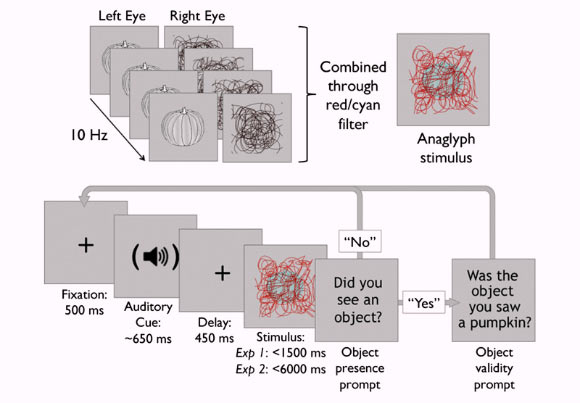Language can play a powerful role in what we see, say Prof Gary Lupyan from the University of Wisconsin and Emily Ward from Yale University.

These images show the procedure of experiments: participants wore red-cyan glasses and viewed stereograms containing a high-contrast red mask and a superimposed lower-contrast cyan object (Gary Lupyan / Emily J. Ward).
What we see is a function not only of incoming visual information, but also how that information is interpreted in light of other visual experiences, and may even be influenced by language.
“Perceptual systems do the best they can with inherently ambiguous inputs by putting them in context of what we know, what we expect,” said Prof Lupyan, who is a first author of the study published in the Proceedings of the National Academy of Sciences.
“Studies like this are helping us show that language is a powerful tool for shaping perceptual systems, acting as a top-down signal to perceptual processes. In the case of vision, what we consciously perceive seems to be deeply shaped by our knowledge and expectations.”
And those expectations can be altered with a single word.
To show how deeply words can influence perception, the scientists used a technique called continuous flash suppression to render a series of objects invisible for a group of volunteers. Each person was shown a picture of a familiar object – such as a chair, a pumpkin or a kangaroo – in one eye. At the same time, their other eye saw a series of flashing lines.
Immediately before looking at the combination of the flashing lines and suppressed object, the participants heard one of three things: the word for the suppressed object (‘pumpkin,’ when the object was a pumpkin), the word for a different object (‘kangaroo, ‘ when the object was actually a pumpkin), or just static.
Then the scientists asked the participants to indicate whether they saw something or not. When the word they heard matched the object that was being wiped out by the visual noise, the subjects were more likely to report that they did indeed see something than in cases where the wrong word or no word at all was paired with the image.
“Hearing the word for the object that was being suppressed boosted that object into their vision,” Prof Lupyan said.
And hearing an unmatched word actually hurt study subjects’ chances of seeing an object.
“With the label, you’re expecting pumpkin-shaped things. When you get a visual input consistent with that expectation, it boosts it into perception. When you get an incorrect label, it further suppresses that.”
Experiments have shown that continuous flash suppression interrupts sight so thoroughly that there are no signals in the brain to suggest the invisible objects are perceived, even implicitly.
“Unless they can tell us they saw it, there’s nothing to suggest the brain was taking it in at all. If language affects performance on a test like this, it indicates that language is influencing vision at a pretty early stage. It’s getting really deep into the visual system.”
The study demonstrates a deeper connection between language and simple sensory perception than previously thought, and one that makes Prof Lupyan wonder about the extent of language’s power. The influence of language may extend to other senses as well.
______
Bibliographic information: Gary Lupyan and Emily J. Ward. Language can boost otherwise unseen objects into visual awareness. PNAS, published online August 12, 2013; doi: 10.1073/pnas.1303312110







